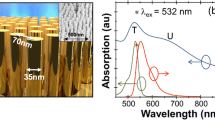Abstract
The fluorescence enhancement of Rhodamine 6G (Rh6G) fluorophore in the close vicinity of porous alumina film with ordered nanohole arrays is investigated. Experimental observations show that the nonmetallic substrate with hole arrays enhances the fluorescence intensity. By comparing the fluorescence emissions that are excited with 325 nm and 532 nm, better fluorescence enhancement is obtained with excitation at a shorter wavelength. The study suggests that higher fluorescence excitation efficiency due to the energy transfer from oxygen vacancies to Rh6G fluorophore molecules is responsible for better fluorescence enhancement. The contribution of the scattering of nanohole arrays to the fluorescence enhancement is also proposed based on the intensity increase and reduced lifetime when the energy transfer from oxygen vacancy is absent. The result of the current study is useful for developing non-metal substrates in the study of spectroscopic enhancement, and is expected to advance the applications of porous alumina to microanalysis.
Similar content being viewed by others
References
Geddes C D, Lakowicz J R. Metal-enhanced fluorescence. J Fluoresc, 2002, 12(2): 121–129
Fort E, Gresillon S. Surface enhanced fluorescence. J Phys D-Appl Phys, 2008, 41(2): 013001
Aslan K, Leonenko Z, Lakowicz J R, et al. Annealed silver island films for metal-enhanced fluorescence. J Fluoresc, 2005, 15(5): 643–654
Zhang Y X, Aslan K, Michael J R, et al. Metal-enhanced fluorescence: Surface plasmons can radiate a fluorophore’s structured emission. Appl Phys Lett, 2007, 90: 053107
Galloway C M, Etchegoin P G, Le Ru E C. Ultrafast nonradiative decay rates on metallic surfaces by comparing surface-enhanced raman and fluorescence signals of single molecules. Phys Rev Lett, 2009, 103: 063003
Fu C C, Ossato G, Long M, et al. Bimetallic nanopetals for thousand-fold fluorescence enhancements. Appl Phys Lett, 2010, 97: 203101
Lakowicz J R, Radiative decay engineering 3. Surface plasmon-coupled directional emission. Anal Biochem, 2004, 324(2): 153–169
Viger M L, Brouard D, Boudreau D. Plasmon-enhanced resonance energy transfer from a conjugated polymer to fluorescent multilayer core-shell nanoparticles: A photophysical study. J Phys Chem C, 2011, 115(7): 2974–2981
Lakowicz J R. Radiative decay engineering: Biophysical and biomedical applications. Anal Biochem, 2001, 298: 1–24
Zheng H R, Xu L M, Zhang Z L, et al. Fluorescence enhancement of acridine orange in a water solution by Au nanoparticles. Sci China-Phys Mech Astron, 2010, 53(10): 1799–1804
Aslan K, Malyn S N, Geddes C D. Angular-dependent metal enhanced fluorescence from silver island films. J Chem Phys Lett, 2008, 453: 222–228
Zhang Y X, Aslan K, Michael J R. Previte, previte, metal-enhanced fluorescence from copper substrates. Appl Phys Lett, 2007, 90: 173116
Liu G N, Zheng H R, Liu M C, et al. Surface-enhanced fluorescence of Rhodamine 6G on the assembled silver nanostructures. J Nanosci Nanotechnol, 2011, 11(11): 9523–9527
Zhang Z L, Zheng H R, Liu M C, et al. Surface enhanced fluorescence of rh6g with gold nanohole arrays. J Nanosci Nanotechnol, 2011, 11(11): 9803–9807
Alexandre G B, Shing C K, Matthew G M, et al. Enhanced fluorescence from arrays of nanoholes in a gold film. J Am Chem Soc, 2005, 127: 14936–14941
Ray K, Chowdhury M H, Lakowicz J R. Aluminum nanostructured films as substrates for enhanced fluorescence in the ultraviolet-blue spectral region. Anal Chem, 2007, 79(17): 6480–6487
Zhang Z L, Zheng H R, Xu L M, et al. Fluorescence enhancement of mechanically polished metallic surfaces to Acridine orange in a sandwiched configuration (in Chinese). Sci Sin-Phys Mech Astron, 2010, 40(3): 280–286
Johansson P, Xu H X, Käll M. Surface-enhanced Raman scattering and fluorescence near metal nanoparticles. Phys Rev B, 2005, 72: 035427
Huang G S, Wu X L, Mei Y F, et al. Strong blue emission from anodic alumina membranes with ordered nanopore array. J Appl Phys, 2003, 93(1): 582–585
Mehmood M, Rauf A, Rasheed M A, et al. Preparation of transparent anodic through-thickness anodic alumina with ordered nanochannels by oxidation of aluminum sheet. Mater Chem Phys, 2007, 104(2–3): 306–311
Kopp O, Lelonek M, Knoll M. The influence of pore diameter on bifurcation and termination of individual pores in nanoporous alumina. J Phys Chem C, 2011, 115(16): 7993–7996
Xiao Z L, Han C Y, Welp U, et al. Fabrication of alumina nanotubes and nanowires by etching porous alumina membranes. Nano Lett, 2002, 2(11): 1293–1297
Wang Z Y, Chen Z J, Lan Z H, et al. Enhancement of Alq3 fluorescence by nanotextured silver films deposited on porous alumina substrates. Appl Phys Lett, 2007, 90: 151119
Friedman A L, Chun H, Jung Y J, et al. Possible room-temperature ferromagnetism in hydrogenated carbon nanotubes. Phys Rev B, 2010, 81: 115461
Tsai H Y, Liu H C, Chen J H, et al. Low cost fabrication of diamond nano-tips on porous anodic alumina by hot filament chemical vapor deposition and the field emission effects. Nanotechnology, 2011, 22(23): 235301
Jia R P, Shen Y, Luo H Q, et al. Enhanced photoluminescence properties of morin and trypsin. Solid State Commun, 2004, 130(6): 367–372
Gaponenko N V, Molchan I S, Lutich A A, et al. Enhanced Luminescence of europium in porous anodic alumina films. Solid State Phenom, 2004, 97(98): 251–258
Du Y, Cai W L, Mo C M, et al. Preparation and photoluminescence of alumina membranes with ordered pore array. Appl Phys Lett, 1999, 74(20): 2951–2953
Forster T. Transfer mechanisms of electronic excitation. Discuss Faraday Soc, 1959, 27: 7–17
Peelen J G J, Metselaar R. Light scattering by pores in polycrystalline materials: Transmission properties of alumina. J Appl Phys, 1974, 45: 216–220
Lakowicz J R. Principles of Fluorescence Spectroscopy. 2nd ed. Berlin: Springer-Verlag, 1999. 9
Author information
Authors and Affiliations
Corresponding authors
Rights and permissions
About this article
Cite this article
Zhang, Z., Zheng, H., Dong, J. et al. Surface enhanced fluorescence by porous alumina with nanohole arrays. Sci. China Phys. Mech. Astron. 55, 767–771 (2012). https://doi.org/10.1007/s11433-012-4681-1
Received:
Accepted:
Published:
Issue Date:
DOI: https://doi.org/10.1007/s11433-012-4681-1




